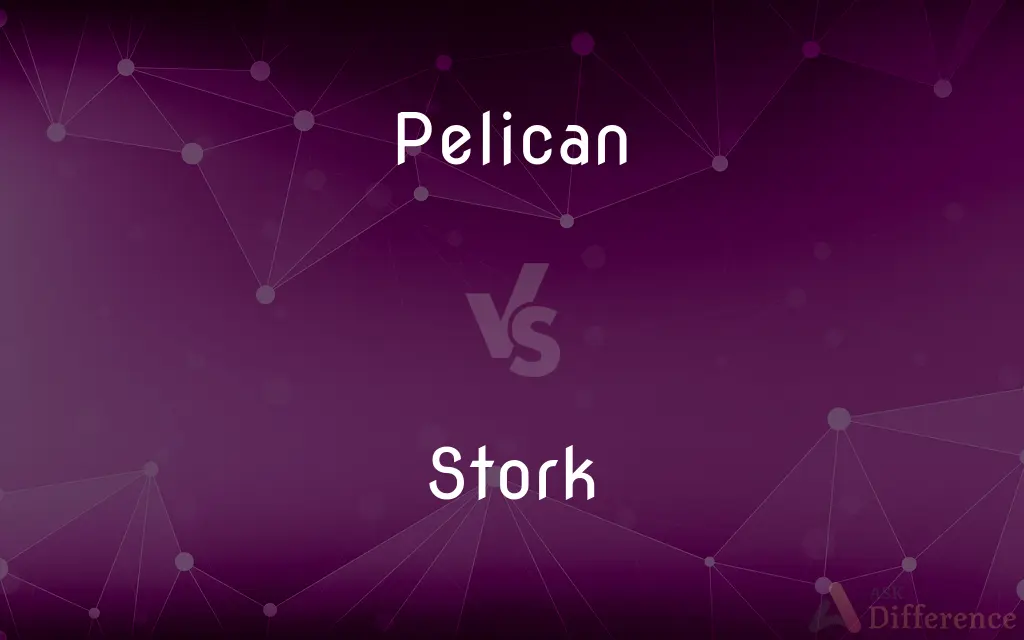Pelican vs. Stork — What's the Difference?
Edited by Tayyaba Rehman — By Fiza Rafique — Updated on September 30, 2023
Pelicans are large water birds known for their long bills with a pouch, while storks are tall, wading birds recognized for their long necks and legs. Both are distinct in appearance and habitat preferences.

Difference Between Pelican and Stork
Table of Contents
ADVERTISEMENT
Key Differences
Pelicans, belonging to the family Pelecanidae, are prominently recognized for their long bills and a large throat pouch. This pouch helps them scoop up fish from the water. Storks, on the other hand, are part of the family Ciconiidae. They have long necks and legs, making them effective waders in shallow waters, hunting for a variety of aquatic animals.
When discussing habitats, pelicans are mostly found near coastlines, lakes, and rivers, using their pouches to trap fish before swallowing. Storks prefer wetlands, grasslands, and tropical forest regions. Their hunting method involves stalking prey patiently before snapping it up quickly with their beaks.
In terms of size and appearance, pelicans are generally bulkier and often display a hunched posture. Their flight is characterized by deep wing beats followed by gliding. Storks, with their upright stance, showcase elegance. They soar effortlessly on thermals while migrating or searching for food.
Comparison Chart
Family
Pelecanidae
Ciconiidae
Hunting Technique
Scoop fish using pouch
Stalk and snap prey
ADVERTISEMENT
Typical Habitat
Coastlines, lakes, rivers
Wetlands, grasslands, forests
Appearance Posture
Bulkier, often hunched
Tall, upright stance
Nesting Location
Ground or low shrubs
High trees, cliffs, structures
Compare with Definitions
Pelican
Bird primarily found near aquatic habitats.
A group of pelicans rested by the lakeside.
Stork
A tall wading bird with long legs and neck.
The stork stood gracefully by the river's edge.
Pelican
Member of the family Pelecanidae.
This bird species is a pelican, recognized by its unique bill.
Stork
Often seen in wetlands and grassy regions.
The wetland was home to several storks.
Pelican
Known for cooperative fishing techniques.
The pelicans formed a line to herd the fish.
Stork
Member of the family Ciconiidae.
That tall, elegant bird is a stork from the Ciconiidae family.
Pelican
Often nests on the ground or low vegetation.
The pelican chicks were safely nestled amidst the shrubs.
Stork
Recognized for its silent flight without vocalization.
The stork soared silently overhead.
Pelican
A large water bird with a distinctive pouch under its bill.
The pelican skillfully scooped up the fish with its pouch.
Stork
Builds large nests atop elevated platforms.
The stork's nest sat high upon the old tree.
Pelican
Pelicans are a genus of large water birds that make up the family Pelecanidae. They are characterized by a long beak and a large throat pouch used for catching prey and draining water from the scooped-up contents before swallowing.
Stork
Storks are large, long-legged, long-necked wading birds with long, stout bills. They belong to the family called Ciconiidae, and make up the order Ciconiiformes .
Pelican
Any of various large, web-footed birds of the genus Pelecanus primarily of tropical and warm regions, having a long straight bill from which hangs a distensible pouch of skin used for catching and holding fish.
Stork
Any of various large wading birds of the family Ciconiidae, having long legs and a long straight bill.
Pelican
Any of various seabirds of the family Pelecanidae, having a long bill with a distendable pouch.
Stork
A large wading bird with long legs and a long beak of the family Ciconiidae.
Pelican
A native or resident of the American state of Louisiana.
Stork
(children's folklore) The mythical bringer of babies to families, or good news.
Pelican
A retort or still having a curved tube or tubes leading back from the head to the body for continuous condensation and redistillation.
Stork
(cartomancy) The seventeenth Lenormand card.
Pelican
(dentistry) A set of forceps used to force overcrowded teeth apart.
Stork
Any one of several species of large wading birds of the family Ciconidæ, having long legs and a long, pointed bill. They are found both in the Old World and in America, and belong to Ciconia and several allied genera. The European white stork (Ciconia alba) is the best known. It commonly makes its nests on the top of a building, a chimney, a church spire, or a pillar. The black stork (C. nigra) is native of Asia, Africa, and Europe.
Pelican
Any large webfooted bird of the genus Pelecanus, of which about a dozen species are known. They have an enormous bill, to the lower edge of which is attached a pouch in which captured fishes are temporarily stored.
Stork
Large mostly Old World wading birds typically having white-and-black plumage
Pelican
A retort or still having a curved tube or tubes leading back from the head to the body for continuous condensation and redistillation.
Pelican
Large long-winged warm-water seabird having a large bill with a distensible pouch for fish
Common Curiosities
Do pelicans only eat fish?
While fish are their primary diet, pelicans can consume other small aquatic animals.
Do storks migrate?
Yes, many stork species are migratory, traveling vast distances.
Are pelicans found worldwide?
Pelicans are found on all continents except Antarctica.
Are storks responsible for delivering babies as per the myth?
It's a popular folklore, but storks don't deliver babies.
Can pelicans float?
Yes, pelicans can float thanks to air sacs in their bodies.
How do pelicans communicate?
They use vocalizations and body gestures, especially during breeding.
Are pelicans social birds?
Yes, they often live and hunt in groups.
How do pelicans store fish in their pouch?
The pouch acts as a net, not storage. They'll drain water and swallow the fish.
How big can a stork's nest get?
Some nests can grow to over 6 feet in diameter, used year after year.
Why do storks stand on one leg?
It's believed to conserve body heat and energy.
Is the stork a symbol in any cultures?
Yes, in many cultures, storks symbolize fertility and good luck.
How long is a pelican's lifespan?
In the wild, they can live up to 15-25 years.
Are all storks white?
No, stork species vary in color, including black, white, and grey.
What do storks eat?
Storks consume a variety of prey, from fish to frogs, insects, and small mammals.
How many species of pelicans and storks exist?
There are 8 species of pelicans and 19 species of storks.
Share Your Discovery

Previous Comparison
Germane vs. Relevant
Next Comparison
Fuzz vs. BuzzAuthor Spotlight
Written by
Fiza RafiqueFiza Rafique is a skilled content writer at AskDifference.com, where she meticulously refines and enhances written pieces. Drawing from her vast editorial expertise, Fiza ensures clarity, accuracy, and precision in every article. Passionate about language, she continually seeks to elevate the quality of content for readers worldwide.
Edited by
Tayyaba RehmanTayyaba Rehman is a distinguished writer, currently serving as a primary contributor to askdifference.com. As a researcher in semantics and etymology, Tayyaba's passion for the complexity of languages and their distinctions has found a perfect home on the platform. Tayyaba delves into the intricacies of language, distinguishing between commonly confused words and phrases, thereby providing clarity for readers worldwide.














































